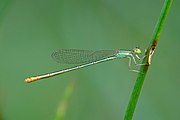아그리오크네미스피그메아
Agriocnemis pygmaea| 피그미주머니쥐 | |
|---|---|
 | |
| 남자 | |
 | |
| 여자 | |
| 과학적 분류 | |
| 왕국: | 애니멀리아 |
| 문: | 절지동물 |
| 클래스: | 곤충류 |
| 주문: | 오도나타 |
| 서브오더: | 접합테라속 |
| 패밀리: | 코에나그리온과 |
| 속: | 아그리오크네미스 |
| 종류: | 피그메아 |
| 이항명 | |
| 아그리오크네미스피그메아 | |
 | |
| 동의어 | |
| |
멧돼지는[3] [5]멧돼지와에 속하는 멧돼지는 멧돼지의 일종이다.[4]그것은 또한 떠돌이 난쟁이, 피그미 다트렛 또는 떠돌이 다트라고 알려져 있다.아시아와 호주의 [1][6]일부 지역에 잘 분포되어 있다.
설명 및 거주지
검은 눈이 덮인 녹색 눈, 검은 흉부에 사과 녹색 줄무늬가 옆면에 있는 작은 담비입니다.복부 1에서 7부분은 등쪽은 검은색이고 복부 절반은 옅은 녹색이다.나머지 세그먼트는 주황색-빨간색입니다.아주 나이든 수컷은 머리 뒤통수와 흉곽에 눈처럼 하얗게 칠해져 밑에 있는 모든 반점이 잘 보이지 않을 수 있다.암컷은 더 튼튼하고 여러 가지 색상의 형태를 보인다.수컷의 녹색은 암컷의 빨간색으로 대체된다.안드로크롬 형태에서 암컷은 [7]수컷과 같은 녹색을 띤다.여성 색상의 변화는 [8]또한 성적 발달과 관련된 존재 유발 색상의 변화에 의존한다.
그것은 늪과 [7][9][10][11][12]연못에서 번식한다.
어원학
피그메아라는 이름은 피그미를 뜻하는 그리스어에서 유래했다.1842년, 라틴어로 쓴 쥘 피에르 람부르는 이 댐에 대한 그의 묘사를 시작했다: 최소 무명 바이리디 에이넘 - 매우 작은 짙은 녹색 구리.[2][13]
갤러리
「 」를 참조해 주세요.
레퍼런스
Wikimedia Commons에는 Agriocnemis pygmaea와 관련된 미디어가 있습니다.
Wikis 종족은 Agriocnemis pygmaea와 관련된 정보를 가지고 있다.
- ^ a b Subramanian, K.A. (2020). "Agriocnemis pygmaea". IUCN Red List of Threatened Species. 2020: e.T167280A83374189. doi:10.2305/IUCN.UK.2020-1.RLTS.T167280A83374189.en. Retrieved 20 November 2021.
- ^ a b Rambur, Jules (1842). Histoire naturelle des insectes. Névroptères (in French). Paris: Librairie Encyclopédique de Roret. pp. 534 [278] – via Gallica.
- ^ Dennis Paulson; Martin Schorr; Cyrille Deliry. "World Odonata List". University of Puget Sound. Retrieved 15 Feb 2022.
- ^ Theischinger, Günther; Hawking, John (2006). The Complete Field Guide to Dragonflies of Australia. Collingwood, Victoria, Australia: CSIRO Publishing. p. 102. ISBN 978 0 64309 073 6.
- ^ "Species Agriocnemis pygmaea (Rambur, 1842)". Australian Faunal Directory. Australian Biological Resources Study. 2012. Retrieved 6 April 2017.
- ^ K.A., Subramanian; K.G., Emiliyamma; R., Babu; C., Radhakrishnan; S.S., Talmale (2018). Atlas of Odonata (Insecta) of the Western Ghats, India. Zoological Survey of India. pp. 142–143. ISBN 9788181714954.
- ^ a b C FC Lt. Fraser (1933). The Fauna of British India, including Ceylon and Burma, Odonata Vol. I. Red Lion Court, Fleet Street, London: Taylor and Francis. pp. 398-401.
- ^ Joshi, Shantanu; Agashe, Deepa (2020). "Ontogenic colour change, survival, and mating in the damselfly Agriocnemis pygmaea Rambur (Insecta: Odonata)". Ecological Entomology. doi:10.1111/een.12879. Retrieved 1 May 2020.
- ^ C FC Lt. Fraser (1924). A Survey of the Odonate (Dragonfly) Fauna of Western India and Descriptions of Thirty New Species (PDF). p. 490.
- ^ Subramanian, K. A. (2005). Dragonflies and Damselflies of Peninsular India - A Field Guide.
- ^ "Agriocnemis pygmaea Rambur, 1842". India Biodiversity Portal. Retrieved 2017-02-26.
- ^ "Agriocnemis pygmaea Rambur, 1842". Odonata of India, v. 1.00. Indian Foundation for Butterflies. Retrieved 2017-02-26.
- ^ Endersby, Ian; Fliedner, Heinrich (2015). The Naming of Australia's Dragonflies. Eltham, Victoria, Australia: Busybird Publishing. ISBN 9781925260625.







